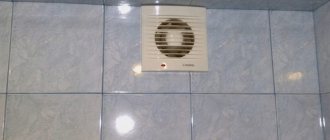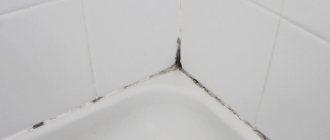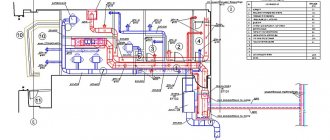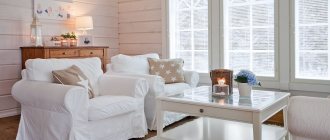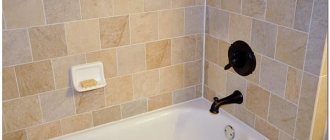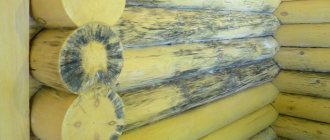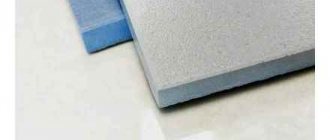High humidity inside the home brings people a lot of trouble. Excessive dampness affects both the interior of the room (fungus and mold appear on the surface of the walls) and the health of the residents. This is due to the fact that fungal formations cause allergic reactions, colds, and bronchial asthma. Most often, small children suffer in this situation: changes in humidity lead to impaired immunity. Therefore, if dampness appears in the house, you must get rid of it immediately. Moreover, this must be done as soon as possible, using any available methods.
The use of plasterboard in the bathroom can significantly speed up the work process and reduce the cost of leveling the wall surface Source img.wattpad.com
Why does high humidity occur in the house?
Moisture inside a home appears in two ways: it penetrates from the outside or accumulates from the inside. The first case indicates mistakes were made during construction work, the second situation is typical for rooms with excessive condensation formation.
External causes of dampness in the house:
- the presence of unclosed gaps in the roof, through which precipitation (snow, rain) periodically penetrates into the home;
- gradual destruction of the foundation due to the lack of tide, as a result of which moisture accumulates under the floor covering;
- the formation of multiple cracks on the walls of the building;
- the use of a material (for example, plastic) for cladding a house that does not “breathe” and contributes to the accumulation of moisture inside the building;
- improper arrangement of supply and exhaust ventilation;
- close occurrence of groundwater in the absence of high-quality waterproofing from the outside and inside of the building.
Important! Dampness in a newly built wooden house often appears as a result of the use of poorly dried wood during construction.
There are several types of drywall, but for bathroom renovations only moisture-resistant material can be used Source zhk-akvapolis.rf
Where is the border between normal humidity and dampness?
Depending on the sources, recommendations on this matter may differ, but there is GOST for this case. In accordance with the state standard (GOST 30494-2011), which determines the microclimate parameters in residential premises, in winter humidity should be in the range from 30% to 45%, but not more than 60%, and in summer - in the range from 30% to 60% , but not more than 65%.
To be clear, we are talking about living rooms: bedrooms, living rooms and dining rooms. For toilets, kitchens and bathrooms, humidity is not standardized by GOST and can reach up to 100%. It is also worth noting that excessive dry air is no less harmful than dampness. During the heating season, you need to pay special attention to controlling the level of humidity: during this period, conditions are created in the apartment under which it can drop to critical values (15-20%). This humidity is typical for the Sahara Desert.
Air humidity is measured using a household device such as a hygrometer. It can be present as a function in many electronic devices - home weather stations, air washers, smart watches.
Why is dampness dangerous?
Excessive moisture inside a home has a negative impact on the health of permanent residents. Elderly people and young children suffer the most from fungus and mold. The most common consequences of prolonged exposure to a damp room are:
- development of dermatoses, mycoses;
- allergic reactions;
- the appearance of asthmatic attacks;
- frequent colds;
- headache;
- nausea;
- constant malaise;
- sleep disturbance;
- dizziness.
Attention! Increased moisture levels in the home often provoke exacerbation of chronic diseases in people. Therefore, it is extremely important to maintain an optimal humidity of 40-60% in the house.
Diseases from high humidity Source samstroy.com
Causes
Maintaining an optimal level of humidity in the house is necessary not only for the health of all residents, but also for the furniture.
If it is too high, you should first find out the reason. After discovering the reason why indoor air humidity is high, you can look for how to get rid of the problem.
Problems leading to its increase:
- Bathroom. Condensation often occurs in this room. The hotter the water gets, the more moisture gets into the air. Condensation is a serious problem, so you need to equip your bathroom in such a way that steam does not leak into other rooms.
- Boiling water on the stove, soup or borscht also lead to its increase. The released vapors enter the air, increase its humidity, and can cause damage to the cabinets.
- Drying clothes inside. If possible, hang or lay out your washed items on the balcony or outside in the shade. The moisture that evaporates during drying enters the air.
- Gas boilers burn gas to produce heat. This process is called combustion. This creates harmful combustion products and steam. A leaky gas heater does not have a flue and releases pollutants and water vapor directly into the apartment.
- Poor ventilation. Poor air quality in a room depends on the level of ventilation, including how much fresh air enters the apartment from outside. Good ventilation eliminates stale indoor air and reduces indoor air pollutants. It also helps limit the build-up of internal moisture, which can promote mold growth.
- Coastal air. Relative humidity depends on temperature and geographic location. Warmer air holds more moisture than cooler air, and warmer weather promotes evaporation. Areas with a lot of surface water, such as coastal areas, have high levels of water vapor in the gas.
- Regions with high rainfall. During the cold winter months, moisture levels in the home can become quite high.
In order for the humidity in the room to be normal, the air must circulate freely. You can also create your own conditions to reduce it.
How to eliminate damp smell
The unpleasant smell of dampness often comes from furniture, things, walls, floors, and ceilings. You can remove it using special and folk remedies:
- Air ionizers and other preparations designed to eliminate unpleasant odors in rooms. They are sold in construction stores or department stores.
- Essential oils. They must be added to clean water, then rinsed off floors and other surfaces.
- Vinegar with water. It is recommended to mix these components in equal proportions and spray the resulting solution in areas with the most pronounced mold smell.
- Soda. Prepare an aqueous solution (1 tablespoon of soda powder per 200 ml of liquid), treat all places where the fungus is present.
- Hydrogen peroxide, bleaches. Apply directly to mold affected areas.
- Chlorine-containing products. Add to water, which is then used to wash floors, wall tiles, and other surfaces suitable for wet treatment.
- Ammonia. As part of an aqueous solution, it is generously applied to problem areas.
Important! The smell of dampness in an apartment or house indicates the presence of fungus in the home. To remove an unpleasant odor, its source must be destroyed.
Moisture-resistant plasterboard sheets are mounted close to each other; for additional protection from moisture, all joints and corners can be treated with sealant Source st5.stblizko.ru
How does a dehumidifier work?
There are several types of indoor dehumidifiers. They differ in operating principle and design features:
- evaporative - driving streams of moist air through the evaporator, returning it dried back to the room, and excess moisture flows into the tank;
- adsorption - air passes through the adsorbent, which absorbs excess moisture, while at the same time, with the help of hot air, the process of drying the adsorbent occurs. The air comes back not only dry, but also purified;
- assimilation - takes moist air masses from the room and throws them outside into the atmosphere.
Air dryers
How to get rid of humidity at home
In a private building, it is much easier to eliminate excess moisture than in an apartment, where the appearance of mold is often caused by a violation of the construction technology of the entire building.
Laying waterproofing
Before dealing with dampness inside the building, you need to tackle the basement (if there is one). The use of concrete-containing dry mixtures will help normalize humidity. Using the latter, you need to plaster the area under the floor, seal all the cracks and crevices. For air outflow, it is necessary to install a hood with access to the street.
Then you need to move on to waterproofing the entire house. To do this, carefully plastering the external walls is performed. In a wooden building, the gaps between the logs are sealed with tow or glass wool.
It is important to pay special attention to the roof, even if there are no visible leaks. To prevent moisture from penetrating through the roof, its interior should be finished with any waterproofing material.
The next stage is the implementation of internal waterproofing of the building. Drywall is perfect for all rooms, but for the bathroom it is important to use a moisture-resistant type of such material or plastering.
If the neighbors above flood the plasterboard ceiling in the bathroom, it will have to be replaced: it will not be able to withstand such a load Source ogipse.ru
Redecorating
How to remove moisture in a house if it is not possible to carry out major repairs? In such cases, it is worth trying to perform surface repairs.
Procedure:
- Remove wallpaper damaged by dampness.
- Clean the surface from fungus, treat with an antiseptic (for example, copper sulfate).
- Wait a few days until the room dries out, or use a heater.
- Apply a layer of primer to the walls, and then plaster them or cover them with plasterboard.
- Finish the wall surfaces (hang wallpaper, paint).
It is advisable to replace the floor covering, even if it is not badly damaged, with a new one.
Arranging a plasterboard box is an excellent solution in cases where you need to hide risers or beds with a large diameter Source sovety-vannoy.ru
Do-it-yourself dehumidifier for an apartment
Why do you need to buy an air dehumidifier if you can independently and quite easily construct it from improvised means at home?
First way
- Arm yourself with glass or plastic containers with a volume of 0.5 liters.
- Next, pour regular salt into the container, about halfway.
- To eliminate unpleasant odors in your home, add a few drops of your favorite essential oil to the salt.
- Place these containers in areas most prone to high humidity.
- Change damp salt as needed.
Second way
- Take two 2 liter bottles.
- Cut the first bottle in half; you will need both halves.
- In the lower half, use a hot, sharp object to carefully make two holes for the future release of air.
- Then fill the resulting container with silica gel, a litter used for cat litter.
- Take the top half without the lid and close the throat hole with a bandage folded into several parts.
- Place the top part into the bottom part, neck down.
- Cut off the bottom of the second bottle.
- Place a small fan from a computer processor in the resulting hole so that it draws air into the bottle through the neck and passes it through the adsorbent.
- Place this bottle with the neck up on the first one, secure the structure with electrical tape.
The dehumidifier is ready for use. After a couple of days, the filler must be replaced with a new one or dried under high temperatures.
How to reduce indoor humidity: preventive measures
Since it is not at all easy to remove dampness from the house, it is recommended to prevent excessive accumulation of moisture inside the home and follow these instructions:
- Ventilate the rooms periodically. It is possible to reduce the humidity in a room by regularly ventilating it. It is advisable for the kitchen window to be slightly open at all times, especially while preparing food. This is due to the fact that vapors emanating from boiling liquids condense on all surfaces, quickly absorb into the walls, and provoke the appearance of fungus.
- Eliminating sources of moisture. Often the main culprit for the spread of mold inside the house is wet laundry. If the premises are not equipped with a high-quality ventilation system, drying things in them is prohibited.
- Heating. In winter, heating devices should be turned on at the required power to keep the rooms warm and comfortable. Savings often lead to irreversible consequences: the growth of fungus on all surfaces, the appearance of mold even in cabinets.
Advice! In summer, windows should not be completely covered with curtains. Then the sun's rays will freely penetrate into the home, warm and dry it.
Before installing drywall in the bathroom, it is advisable to install a reliable metal frame Source guruotdelki.ru
Breakdowns
Walls that have cracks or holes can also allow moisture into the room. Warm, moist air from outside can travel indoors through openings during warm or cold weather. This leads to condensation on the materials.
If mold appears, it should be removed. Simple sprays will not help here; you need to remove the layer of plaster, protect it, use sealant and other means, only then glue the wallpaper.
If the humidity is high, you can lower it by correcting the damage. You need to check where pipes or faucets are leaking. If this is the problem, carry out repair work.
The joints in the bathroom where water gets in are treated with sealant.
The best drugs for dampness
There are many industrial products designed to combat high humidity in the home. Each of them has positive and negative sides and is used under specific circumstances. The most effective drugs are considered to be the following:
- Biocide. Eliminates fungus outside and inside the building and is characterized by significant effectiveness. Its main drawback is its high cost (800 rubles per 10 liters).
- Fongifluid. A ready-made solution that can be applied to almost all surfaces and coatings. Consumers note low product consumption and affordable price (550 rubles for 2 liters)
- Dali. A highly effective drug with a low cost (150 rubles per 0.6 l). It can be applied to all surfaces, including wallpaper and tiles.
It will be much easier to get rid of dampness in a private house or apartment if you initially accurately determine the source of its formation and spread. You can cope with this task yourself; in difficult situations, you should use the services of specialists.
When caring for plasterboard walls in the bathroom, it is not recommended to use acid-containing detergents Source krasimsami.com
Folk recipes
Salt and sugar are highly hygroscopic.
In addition to the methods listed above, there are also folk recipes that will help eliminate dampness in your home:
- If there is high humidity, you can place containers with salt, sugar, calcium chloride, charcoal or quicklime in the corners of the room. These substances are highly hygroscopic, therefore, they will quickly absorb excess moisture. Such containers need to be changed periodically.
- When humidity is high, bricks will help. It would seem, how to reduce humidity with bricks? Very simple, but only if there is a man in the house. The bricks must be heated and placed on a fireproof tray, near the moldy wall. This must be done until the dampness goes away forever. But it should be remembered that after the tenth heating, the bricks will no longer absorb moisture. Be sure to follow safety precautions when using this method. There should be no flammable things near the bricks.
- You need to clean a damp apartment using “drying” agents. This could be bleach, potassium permanganate solution or vinegar. After you have wiped all surfaces and floors, you should once again “walk” through these places with a dry cloth.
When using silica gel to reduce humidity, be careful if there are small children in the house.
- When high humidity in the apartment makes it difficult to live, use silica gel. This is the kind of product that can often be found in small packets in shoe boxes. They can be purchased in large quantities at pet stores, as they are used in cat litter. Spread this product around the apartment, you can also pour it under the bath. Only use silica gel if you do not have small children who might eat it.
- You can get rid of mold by using this solution. Dissolve salicylic acid in alcohol and dilute with water. Apply the solution to the pre-dried wall. This will help destroy the gray mold patches and dry out the air a little.
- Copper sulfate will also help fight mold. Gray traces must be scraped off and the wall treated with copper sulfate solution. It can be replaced with bleach, bleach, vinegar, soda or soap solution.
Effective ways to reduce humidity
And yet, the problem of high humidity in the apartment can be solved. Below we discuss in detail several ways to combat it, which will not be difficult to implement. To achieve the desired result, it makes sense to use several of them simultaneously.
In order to make sure that the air humidity in the room is exceeded, we suggest using the following devices.
Option No. 1 - ventilation of the apartment
The proposed method of air drying is simple and accessible, but at the same time quite effective. Please note that it is necessary to ventilate the room only in dry and windy weather - otherwise the event loses all meaning.
It is especially important to ventilate after cooking, taking water procedures, washing or general cleaning, accompanied by the use of a washing vacuum cleaner.
Ventilation is the simplest, but at the same time very effective way to combat high humidity in an apartment. In addition, by ventilating the room, you provide an influx of fresh air enriched with oxygen.
An interesting point about how to reduce the humidity level in an apartment in summer, spring and winter. Everything is very simple - to solve the problem, if the humidity is high, but not too much, a powerful fan will do.
Using this device, you can dry the air in the room - it is not always possible to ventilate it.
Option #2 - heaters and dehumidifiers
If the humidity levels in the room exceed all permissible limits and you constantly feel damp, you will have to think about buying household dehumidifiers. Unlike industrial devices, these are compact and operate silently. And they do not have to work constantly - to successfully combat humidity, it will be enough to turn on the device 2-3 times a week.
The use of heaters in the cold season, outside the heating period, not only provides pleasant warmth, but also reduces the humidity in the room
In the cold season and early spring, heating devices provide excellent protection from dampness. The heat they generate significantly dries the air - but you need to be careful here, because there is a risk of drying it out.
In order not to overdo it in the fight against high humidity, do not use heaters during the heating season.
Option No. 3 - modern finishing materials
Do you want to provide long-term protection against dampness? Prepare for a major overhaul.
The use of non-natural materials contributes to an increase in humidity in the apartment, so it makes sense, if possible, to avoid the use of plastic and other types of finishes that retain moisture.
Carrying out “drainage” repairs involves performing the following activities:
- Removing remnants of previous finishing.
- Eliminate, if possible, the source of increased dampness.
- Using a heat gun allows you to dry the walls very well.
- Carefully seal all possible sources of high humidity. First of all, you need to pay attention to the joints of the walls and floor seams. For this purpose, the cracks are filled with cement mortar and treated twice with hydro- and bioprotective compounds. The most commonly used sealants are silicone based.
- The walls need to be treated with a water-repellent primer or bioprotection. The ideal option is to use both means.
- The prepared room must be finished with moisture-resistant plasterboard - one that has a green tint. The thickness of the plasterboard sheets is about 10–12 mm.
For interior decoration of homes with high humidity, non-woven wallpaper with vinyl coating should be used. This coating effectively resists moisture.
Moreover, when cleaning, non-woven wallpaper can be wiped with a damp cloth. If you do not want to use non-woven wallpaper, compact vinyl wallpaper will do.
Coating with acrylic paint not only prevents an increase in air humidity in the apartment and protects against fungus, but also looks great, allowing you to implement any design solutions
Acrylic paint and putty is a combination ideal for treating walls in rooms with high humidity. Acrylic itself is highly water-resistant, and mixed with putty, it provides a reliable water-repellent film.
Another suitable option for decorating wet rooms is ceramic tiles. But its high price limits its scope, so in the vast majority of cases its scope of use is limited to the kitchen and bathroom.
Although, if funds allow, living rooms can also be tiled, only the tiles themselves should be larger in size than those that were used to prevent the increase in humidity in the rooms mentioned above.
Option number 4 - anti-damp tablets
An effective remedy is special absorbent tablets. For example, Ceresit “Stop Moisture”, Henkel “Stop Moisture”. They are used in conjunction with a desiccant - a container into which the brine solution formed from the absorbed moisture flows. The proposed product can absorb about 0.4 liters of water per month.
Using anti-damp tablets is perhaps the simplest and most effective way to combat constantly high indoor humidity. They are ineffective only in the most advanced cases, when major repairs are necessary
Please note that the area of the room in which the absorbent tablet is used cannot be more than 20 square meters. m. 1 tablet can be used for 2-3 months.
Option No. 5 - folk remedies
If the air humidity in your apartment is slightly exceeded and dampness is not particularly felt, at least it does not lead to the formation of fungus.
Or the problem is acute and needs to be solved urgently, but at the moment you do not have enough money to begin a full-fledged repair, you can try to combat high humidity in the room with folk remedies.
Products with absorbent properties
Food products with proven absorption properties are:
- salt;
- sugar;
- rice cereal;
- coffee beans.
It is clear that there is no need to place bags of salt, rice or sugar right in the middle of the rooms. It is enough to pour the products listed above into small containers and place them in inconspicuous places - under the bed, on the chest of drawers, etc.
From coffee beans you can get not only a tasty and invigorating drink, but also an excellent remedy for combating high humidity in the apartment
At the same time, you need to remember that using sugar as a moisture-absorbing agent is fraught with attracting unwanted neighbors to your home - all kinds of insects like cockroaches, ants, etc., which are much more difficult to deal with than with high humidity.
Therefore, it is better to use any other products as natural absorbents. By the way, with the help of coffee beans you can make a beautiful decorative composition in a glass thicket - all you need to do is add other bright components there.
Using Silica Gel
Silica gel is a compound whose sachets can be found in many industrial products made from genuine leather (shoes, bags, wallets). The compound perfectly absorbs moisture. The only thing is that to reduce the humidity in the room, the amount of silica gel that you get with shoes and other leather products will clearly not be enough.
Who would have thought that with the help of these small bags you could solve the problem of high humidity in your home?
You can buy absorbent at a pet store - they sell silica gel as a component for cat litter. When working with silica gel, be extremely careful: under no circumstances should small children who want to try everything “by tooth” should have access to silica gel balls.
The ideal option is to use silica gel not in bulk, but to spread out fabric bags filled with this material.
Calcium chloride, coal and quicklime
If high humidity is observed exclusively in the non-residential areas of your apartment - pantry, vestibule, balcony, then it is permissible to use the substances listed above as absorbents. But in no case should they be used to reduce the humidity of a residential premises - this can cause a sharp deterioration in the health of household members.
The principle of using the substances listed above as absorbents is extremely simple. Calcium chloride, charcoal and quicklime are poured into containers previously placed in the corners of the damp room.
That's it, nothing else is needed - after six months the composition of the containers will need to be replaced, because the substance will be saturated with moisture to the limit.
Coal can become not only fuel for a fireplace, but also a means of combating high humidity. Use only large layers and do not break them
The safest option suitable for reducing humidity in living rooms is coal. However, you need to carefully ensure that it does not become a source of coal dust: this will have a detrimental effect on the health of household members.
Choose only large pieces of coal and under no circumstances place coal in walk-through areas. Lime is suitable for reducing humidity on a loggia/glazed balcony. If you are going to use calcium chloride as an inexpensive absorbent, do not forget to thoroughly dry it in the oven before use and then grind it.
Indoor flowers in the fight against humidity
Many people don’t even realize that some plants effectively absorb moisture, so indoor flowers can be used to solve the problem of increased dampness!
So, if you wish, you can combine business with pleasure by having indoor flowers that absorb excess moisture from the air. Please note that not all plants are able to absorb moisture effectively.
Absorbents of natural origin include:
- geranium;
- spathiphyllum;
- fern;
- myrtle;
- lemon;
- a coffee tree;
- laurel;
- syngony.
Only geraniums can be grown at home. Because all the other plants listed above need abundant watering.
Geranium will not only decorate your apartment, but will also protect your household from high indoor humidity.
Accordingly, they themselves can easily become a source of dampness and even mold in the room. Especially if there are several flower pots on one windowsill.

